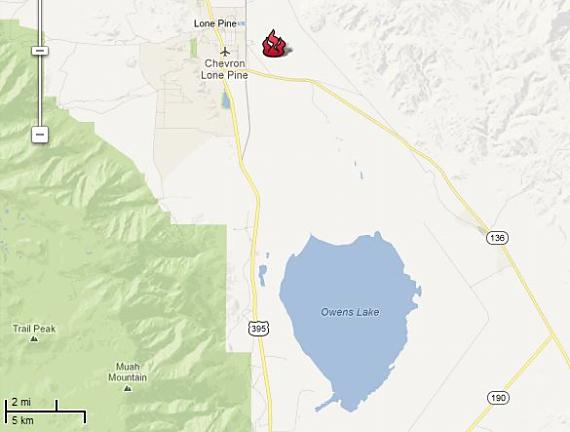Fire burns 407 acres near Lone Pine, California
 CAL FIRE expects to fully contain the River Fire on Thursday which has burned 407 acres east of Lone Pine, California. Thick brush and winds measured at 25 mph challenged the 500 firefighters that initially fought the blaze after it started on Sunday. Remaining on the fire Wednesday morning are 234 personnel, 11 engines, 6 crews, and 2 water tenders. CAL FIRE is calling it 85 percent contained.
CAL FIRE expects to fully contain the River Fire on Thursday which has burned 407 acres east of Lone Pine, California. Thick brush and winds measured at 25 mph challenged the 500 firefighters that initially fought the blaze after it started on Sunday. Remaining on the fire Wednesday morning are 234 personnel, 11 engines, 6 crews, and 2 water tenders. CAL FIRE is calling it 85 percent contained.
Oregon may regulate exploding targets and sky lanterns
A bill has been introduced in the Oregon legislature, HB 3199, that would prohibit the use of sky lanterns (or fire balloons), exploding targets, and tracer ammunition on land within the boundaries of a forest protection district. (UPDATE: the bill was signed by the Governor and will take effect January 1, 2014.)
“Concealed carry is a right, target shooting is not”
Those were the words of Utah state senator Margaret Dayton who resurrected her bill that would give the state forester the authority to ban target shooting on state lands during periods of enhanced wildfire danger. Earlier she withdrew the bill after it received criticism from some shooting enthusiasts. The bill passed the Senate this week along with another that would allow firefighters to access water on privately owned land to aid them in fire suppression efforts.
According to Utah State Forester Dick Buehler, of the 1,528 fires in the state in 2012, 33 were caused by target shooting which cost over $16 million to suppress. In October, 2012 when we wrote about the increasing number of fires started by target shooters using exploding targets, we found 10 fires started by these devices in Utah over a 5-month period last year. One of them burned over 5,500 acres.
Colorado Senate considers legislation regulating prescribed fires
A bill is speeding through the Colorado Senate that would add safeguards to prescribed fires conducted in the state. Senate Bill 13-083 would:
- Establish control over prescribed burning within the Division of Fire Prevention and Control in the Department of Public Safety;
- “Prescribed Burn Managers” must be certified by the Division for prescribed fires occurring on state lands or conducted by state agencies on private lands. This does not apply to “burning conducted by an agency of the federal government”;
- A Prescribed Burn Manager must be on site during a prescribed burn “until the fire is adequately confined to reasonably prevent escape”;
- Allows the Division to collect fees for providing training and certifications.
Getting manufactured crisis fatigue?
While the people we send to Washington to conduct the nation’s business have not passed a federal budget in four years, and they propel us from one manufactured crisis to another, some of us may tire of the hype as we reel from one ridiculous deadline to another. Unfortunately the impacts on the land management agencies from the budget cuts required by the sequester will be significant unless they are reversed within the next few weeks.
On October 13, we first wrote about the sequester, which will require federal wildland fire programs to be cut by at least $218 million, or 8.2 percent.
Here are some excerpts from an article at the Union Democrat with examples of impacts on the National Park Service and U.S. Forest Service in California:
The Associated Press obtained a Park Service memo Friday that detailed some of the planned Yosemite cuts. Staff reductions would end guided ranger programs at Wawona and the Mariposa Grove of Giant Sequoias, eliminate a program in which 3,500 volunteers provide 40,000 hours of activities and mean less frequent trash pickup due to loss of campground staff.
Park administrators fear that less frequent trash pickup would potentially attract bears into campgrounds.
Seasonal road closures like that of Tioga Road may be extended later than usual because there will be less staff available to clear snow.
“The reductions would limit the National Park Service’s ability to sustain a full complement of seasonal employees needed for interpretive programs, maintenance, law enforcement and other visitor services as we are preparing for the busy summer season. Local communities and businesses that rely on recreation to support their livelihoods would face a loss of income from reduced visitation to national parks.”
In the Stanislaus National Forest, cuts could reduce funds available for fuels reductions that help prevent catastrophic forest fires. About $134 million in lost wildland fire management funds would lead to as many as 200,000 fewer acres treated nationwide, U.S. Agriculture Secretary Tom Vilsack wrote in a letter dated Feb. 5 to U.S. Sen. Barbara Mikulski, D-Md., chairwoman of the Senate Appropriations Committee.
The Forest Service is also prepared to close up to 670 of 19,000 developed recreation sites nationwide, such as campgrounds, picnic areas and trailheads, according to Vilsack.
Webinar today: Debunking Myths in Wildland Fire
Today from 1 until 2 p.m. MT:
Sarah McCaffrey will present findings from recent research on social issues of fire management with particular emphasis on the accuracy of various accepted truths about the public and fire management and the variables that actually are associated with approval of different fire management practices.
More info and registration details.
Thanks go out to George
